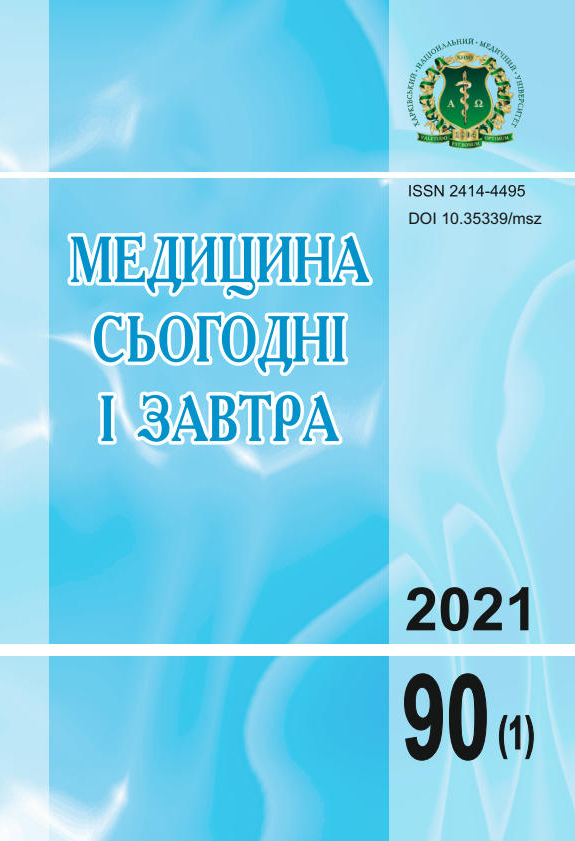Анотація
In press
Проведено порівняльний аналіз клінічних, лабораторних та ендоскопічних даних 80 хворих із неспецифічним виразковим колітом (НВК) 1–3-го ступенів активності і 82 хворих із синдромом подразненого кишечника (СПК) із метою визначення можливих диференційно-діагностичних критеріїв даних захворювань. Установлено, що НВК розвивається з однаковою частотою в чоловіків і жінок, у той час як СПК частіш за все розвивається в жінок. Середній вік хворих із НВК є більшим, ніж середній вік хворих із СПК. НВК частіше розвивається у хворих після 40 років, СПК – у хворих у віці від 18 до 40 років. У хворих із НВК 2-го і 3-го ступенів активності больовий синдром по ходу кишечника зустрічається з однаковою частотою. Розлади стулу зустрічаються з однаковою частотою у хворих із НВК 1–3-го ступенів активності та СПК. У хворих із НВК 2-го і 3-го ступенів активності з однаковою частотою діагностують анемію, підвищений рівень швидкості осідання еритроцитів. Підвищений рівень фекального кальпротектину документують з однаковою частотою у хворих із НВК 1–3-го ступенів активності. Кровотечі в товстому кишечнику є характерною ендоскопічною знахідкою для хворих із НВК 3-го ступеня активності. Ерозивно-виразкові зміни в товстому кишечнику знаходять з однаковою частотою у хворих із НВК 1–3-го ступенів активності. Чітких диференційно-діагностичних критеріїв різних ступенів активності НВК та НВК і СПК за аналізу не виявлено. Одержані дані актуалізують проведення комплексного морфологічного дослідження, яке б дозволило виявити диференційно-діагностичні критерії НВК і СПК, що сприятиме вдосконаленню лікувально-діагностичного процесу у хворих даної категорії та покращить прогноз захворювання.
Ключові слова: диференційно-діагностичні критерії, активний неспецифічний виразковий коліт, синдром подразненого кишечника.
Посилання
Stepanov, Yu. M., Titova, M. V., & Tatarchuk, O. M. (2020). Porushennia mikrobiotsenozu tovstoho kyshechnyka i chastota syndromu nadlyshkovoho bakterialnoho rostu u khvorykh na hronichni zapalni zahvoriuvannia kyshechnyka [Large intestine microbiocoenosis disorders and the incidence of small intestinal bacterial overgrowth syndrome in patients suffering from inflammatory bowel diseases]. Gastroenterologia – Gastroenterology, 54(1), 44–50. DOI: 10.22141/2308-2097.54.1.2020.199141 [in Ukrainian].
Budzak, I. Ya. (2013). K voprosu o differentsialnoi diahnostike vospalitelnykh i funktsionalnykh zabolevanii kishechnika [On the problem of differential diagnosis of inflammatory and functional bowel diseases]. Gastroenterologia – Gastroenterology, 2(48), 81–85. Retrieved from https://cyberleninka.ru/article/n/k-voprosu-o-differentsialnoy-diagnostike-vospalitelnyh-i-funktsionalnyh-zabolevaniy-kishechnika/viewer [in Russian].
Stepanov, Yu. M., Skirda, I. Yu., & Petishko, O. P. (2019). Hvoroby orhaniv travlennia – aktualna problema klinichnoi medytsyny [Digestive system diseases: the actual problem of clinical medicine]. Gastroenterologia – Gastroenterology, 53(1), 1–6. DOI: 10.22141/2308-2097.53.1.2019.163450 [in Ukrainian].
Mikhailova, E. I., & Filipenko, N. V. (2010). Differentsialnaia diahnostika orhanicheskoi i funktsionalnoi patolohii kishechnika na osnove fekalnoho laktoferrina i immunohimicheskoho testa na skrytuiu krov v kale [Differential diagnosis of organic and functional pathology bowels on the basis of fecal lactoferrin and immunochemical hemoccult test]. Problemy zdorovʹâ i èkologii – Health and Ecology Issues, 3, 21–25. Retrieved from https://journal.gsmu.by/jour/article/view/972/944 [in Russian].
Maev, I. V., Bordin, D. S., Eremina, E. U., Ilchishina, T. A., Kaibysheva, V. O., Osipenko, M. F., et al. (2018). Sindrom razdrazhennoho kishechnika. Sovremennyie aspekty epidemiolohii, pato-heneza i lecheniia (obzor) [Irritable bowel syndrome. Modern aspects of epidemiology, pathogenesis and treatment (a review)]. Eksperimentalnaia i klinicheskaia gastroenterologiia – Experimental and Clinical Gastroenterology, 158(10), 68–73. DOI: 10.31146/1682-8658-ecg-158-10-68-73 [in Russian].
Kotze, P. G., Steinwurz, F., Francisconi, C., Zaltman, C., Pinheiro, M., Salese, L., & Ponce de Leon D. (2020). Review of the epidemiology and burden of ulcerative colitis in Latin America. Therapeutic Advances in Gastroenterology, 13, 1–14. DOI: 10.1177/1756284820931739, PMID: 32695230, PMCID: PMC7350039.
Akhmedov, V. A., Sargsyan, A. K., & Gaus, O. V. (2020). Perspektivy ispolzovanija bi-omarkerov v diagnostike sindroma razdrazhennogo kishechnika [Prospects for the use of biomarkers in the diagnosis of irritable bowel syndrome]. Eksperimentalnaia i klinicheskaia gastroenterologiia – Experimental and Clinical Gastroenterology, 175(3), 94–101. DOI: 10.31146/1682-8658-ecg-175-3-94-101 [in Russian].
Kobzar, A. I. (2012). Prikladnaia matematicheskaia statistika [Applied mathematical statistics]. (2nd ed.). Moscow: FIZMATLIT, 816 p. [in Russian].
Epitools. Epidemiological calculators. Access mode: https://epitools.ausvet.com.au/homogeneity.
Runion, R. (1982). Spravochnik po neparametricheskoi statistike: sovremennyi podkhod [Handbook of nonparametric statistics: modern approach]. Moscow: Finance and statistics, 198 p. [in Russian].
Stepanov, Yu. M., Psareva, I. V., Tatarchuk, A. M., Stoykevich, M. V., Petishko, O. P., & Simonova, E. V. (2019). Henderni osoblyvosti rivnia markeriv zapalennia kyshechnyka u khvorykh na nespetsyfichnyi vyrazkovyi kolit [Gender features of the level of intestinal inflammatory markers in patients with ulcerative colitis]. Gastroenterologia – Gastroenterology, 53(4), 252–257. DOI: 10.22141/2308-2097.53.4.2019.182404 [in Ukrainian].
Greuter, T., Manser, C., Pittet, V., Vavricka, S. R., & Biedermann, L. (2020). Gender differences in inflammatory bowel disease. Digestion, 101(1), 98–104. DOI: 10.1159/000504701, PMID: 31995797.
Kim, Y. S., & Kim, N. (2018). Sex-gender differences in irritable bowel syndrome. Journal of Neurogastroenterology and Motility, 24(4), 544–558. DOI: 10.5056/jnm18082, PMID: 30347934, PMCID: PMC6175559.
Magro, F., Gionchetti, P., Eliakim, R., Ardizzone, S., Armuzzi, A., Barreiro-de Acosta, M. et al. (2017). Third European evidence-based consensus on diagnosis and management of ulcerative colitis. Part 1: definitions, diagnosis, extra-intestinal manifestations, pregnancy, cancer surveillance, surgery, and ileoanal pouch disorders. Journal of Crohn’s and Colitis, 11(6), 649–670. DOI: 10.1093/ecco-jcc/jjx008, PMID: 28158501.
Feakins, R. M., & British Society of Gastroenterology. (2013). Inflammatory bowel disease biopsies: updated British Society of Gastroenterology reporting guidelines. Journal of Clinical Pathology, 66(12), 1005–1026. DOI: 10.1136/jclinpath-2013-201885, PMID: 23999270.
Sheptulin A. A., & Vinogradskaya, K. E. (2019). Vospalitelnyie zabolevaniia kishechnika i sindrom razdrazhennoho kishechnika: sochetaniie dvukh nozolohicheskikh form ili raznyie varianty odnoho zabolevaniia? [Inflammatory bowel diseases and irritable bowel syndrome: overlap of two nosological forms or two variants of the same disease?]. Rossiiskii zhurnal gastroenterologii, gepatologii, koloproktologii – Russian Journal of Gastroenterology, Hepatology, Coloproctology, 29(5), 43–48. DOI: 10.22416/1382-4376-2019-29-5-43-48 [in Russian].
Stein, J., & Dignass, A. U. (2013). Management of iron deficiency anemia in inflammatory bowel disease – a practical approach. Annals of Gastroenterology, 26(2), 104–113. PMID: 24714874, PMCID: PMC3959949.
Bjarnason, I. (2017). The use of fecal calprotectin in inflammatory bowel disease. Gastroenterology and Hepatology, 13(1), 53–56. PMID: 28420947, PMCID: PMC5390326.

